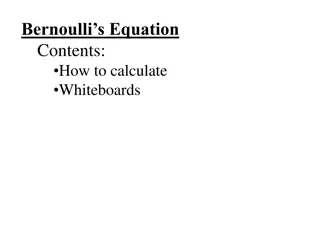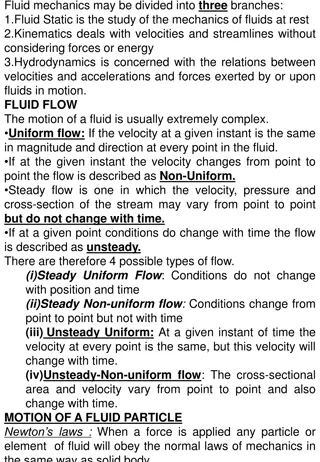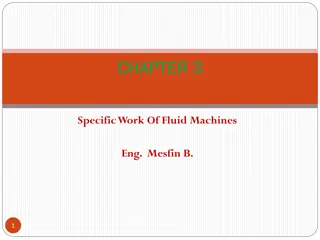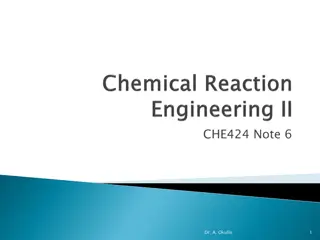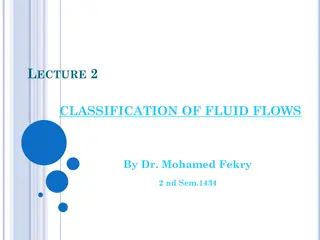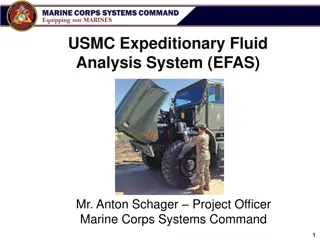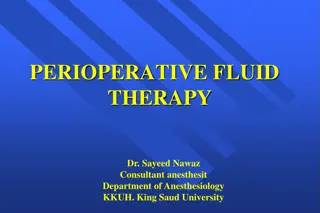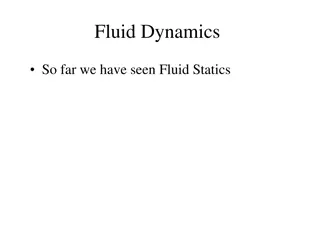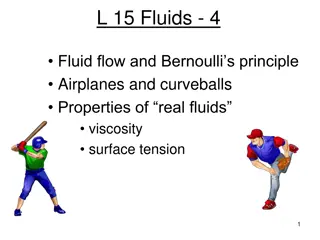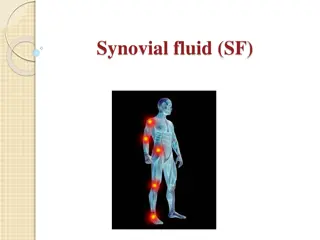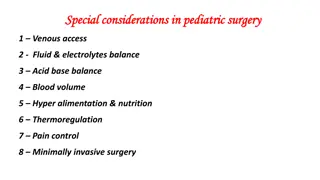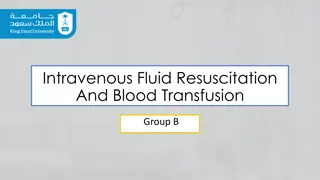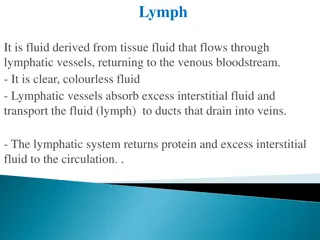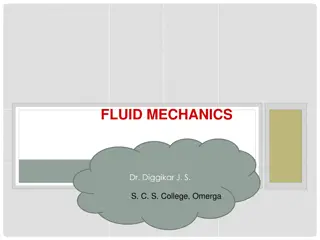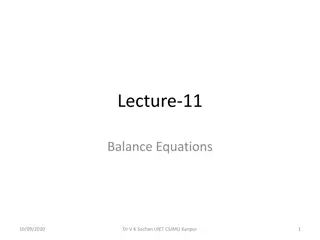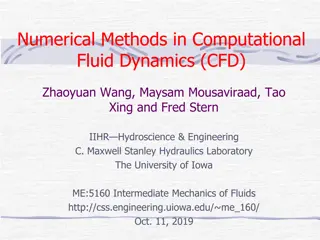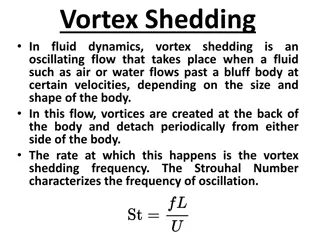Fluid Dynamics and Phenomena Explained
Fluid dynamics and phenomena such as smoke-like clouds, velocity fields, Claude Navier and George Gabriel Stokes' movements of fluids, and more. Understand the basic assumptions, stress components, and diffusion in fluid materials. Learn about the theoretical importance of Navier-Stokes solutions and the Millennium Problems. Dive into topics like advection, pressure, diffusion, and external forces in incompressible, homogeneous fluids.
Download Presentation

Please find below an Image/Link to download the presentation.
The content on the website is provided AS IS for your information and personal use only. It may not be sold, licensed, or shared on other websites without obtaining consent from the author.If you encounter any issues during the download, it is possible that the publisher has removed the file from their server.
You are allowed to download the files provided on this website for personal or commercial use, subject to the condition that they are used lawfully. All files are the property of their respective owners.
The content on the website is provided AS IS for your information and personal use only. It may not be sold, licensed, or shared on other websites without obtaining consent from the author.
E N D
Presentation Transcript
Fluid materials Smoke like phenomena Clouds Dyeing
Velocity(vector field) x = (x, y) position u = (u,v) velocity T time u(x, t) = (u(x, t), v(x, t)) Cartesian grid
Claude Navierand George Gabriel Stokes Movements of fluids Basic assumptions Two components of stress in fluids Diffusion proportional to the gradient of the velocity Pressure
Can describe several physical phenomena Weather Flows in ducts with non-circular cross-section Flows around the wings of aircrafts Movements of solid bodies through fluid like materials (movements in stars in galaxies) Can be connected to the Maxwell equations (Magnetohydrodynamics)
It is also important from theoretical point of view Existence and smoothness of Navier-Stokes solutions in 3D One of the seven Millennium Problems by Clay Mathematics Institute One million dollar for the solution
1 u = + + 2 1 .) ( ) u u p u F t = 2 .) 0 u : density : Viscosity (kinematic) : F External forces Incompressible, homogeneous fluids
Advection ( ) u u Forward movement, transport Any quantity Own vector field as well
Pressure 1 p Force transmission is not instaneousin fluids Molecule collision creates pressure It causes acceleration
Diffusion 2 u Different fluids move differently: there are more dense and more viscous ones Viscosity: the resistance of the fluid against the flow This resistance causes velocity diffusion
External forces F Can be local or global ones (e.g. gravity)
Finite difference form Operator Definition p p p p p p = , 1 + , 1 + , p , 1 , 1 i j 2 i j i j i j , Gradient x y 2 x y u v u u v v u = + , 1 + , 1 + , 1 , 1 i j 2 i j i j i j + Divergence x y + 2 x y + 2 2 p p p p p p 2 2 p p , 1 + , 1 + , , 1 , , 1 i j i j i j i j i j i j = + + 2 p Laplace 2 2 2 2 x y ( ) ( ) x y + + + 4 p p p p p , 1 + , 1 + , 1 , 1 , i j i j i j i j i j = 2 p 2 ( ) x
Analytic solution only in special (simple) cases Numeric method, incremental solution If we would like to animate the flow the time integration could be useful The problem is divided into smaller parts (Stam, J. 1999. "Stable Fluids." In Proceedings of SIGGRAPH 1999)
(A vector can be written as a weighted sum of basis vectors) A vector field can be written as a sum of a divergence-free vector field and gradient of a scalar field , = u = + w u p 0
= + / w u p = + ( ) w u p = + = 2 / 0 w u p u = 2 w p Poisson equation ( x = 2 ) b
= S( ) u P F D A( ) u Projection External Force Diffusion Advection
Euler method, forward step + = + ) ( ) ( ) ( r t t r t u t t Not stable, hard to implement in OpenCL A solution is the backward step : + = ( , ) ( ( , ) , ) q x t t q x u x t t t
u = 2 u t Explicit solution: , ( t x u + = + 2 ) ( , ) ( , ) t u x t t u x t Not stable! Implicit solution: ) ( t I + = 2 ( , ) ( , ) u x t t u x t Poisson equation ( x = 2 ) b
= u w p = 2 w p Poisson equation ( x = 2 ) b
Iterative solution, starting from an initial state and progressive refinement Ax = b Form of the equation: Where is the Laplaceoperator A The most simple solution is the Jacobi method
+ + + + ( ) ( ) ( ) ( ) + k , 1 k , 1 + k , k , x x x x b 1 1 , ) 1 + i j i j i j i j i j = ( k , x i j Diffusion Pressure x velocity (u) pressure (p) u divergence of the velocity field b velocity (u) 1 t -1.0 + 1 4 ( ) 0.25
Calculations are performed only in a finite volume, boundary conditions are needed If the fluid is surrounded with solid walls, the conditions for the velocity and pressure are: Velocity: it is zero at the boundaries (no-slip condition) Pressure: its gradient is zero at the boundaries (Neumann condition)
The simulation and the error of the numeric discretization makes some details of the flow vanish Trying to get it back: op curl u = = ( .) = = ( ) f x vc
Quantities are stored in 2D arrays During the calculations sometime information is needed form the neighborhood, therefore some quantities are double buffered Arrays are updated by OpenCLkernels Separate kernels are needed for different steps of the calculation The display is a simple drawing to the screen Kernel functions.....
__kernel void advection(const int gridResolution, __global float2* inputVelocityBuffer, __global float2* outputVelocityBuffer) { int2 id = (int2)(get_global_id(0), get_global_id(1)); if(id.x > 0 && id.x < gridResolution - 1 && id.y > 0 && id.y < gridResolution 1){ float2 velocity = inputVelocityBuffer[id.x + id.y * gridResolution]; float2 p = (float2)((float)id.x - dt * velocity.x, (float)id.y - dt * velocity.y); outputVelocityBuffer[id.x + id.y * gridResolution] = getBil(p, gridResolution, inputVelocityBuffer); } else{ //hat rfelt telek if(id.x == 0) outputVelocityBuffer[id.x + id.y * gridResolution] = - inputVelocityBuffer[id.x + 1 + id.y * gridResolution]; ... } }
__kernel void divergence(const int gridResolution, __global float2* velocityBuffer, __global float* divergenceBuffer) { int2 id = (int2)(get_global_id(0), get_global_id(1)); if(id.x > 0 && id.x < gridResolution - 1 && id.y > 0 && id.y < gridResolution - 1){ float2 vL = velocityBuffer[id.x - 1 + id.y * gridResolution]; float2 vR = velocityBuffer[id.x + 1 + id.y * gridResolution]; float2 vB = velocityBuffer[id.x + (id.y - 1) * gridResolution]; float2 vT = velocityBuffer[id.x + (id.y + 1) * gridResolution]; divergenceBuffer[id.x + id.y * gridResolution] = 0.5f * ((vR.x - vL.x) + (vT.y - vB.y)); } else{ divergenceBuffer[id.x + id.y * gridResolution] = 0.0f; } }
__kernelvoid pressureJacobi(const int gridResolution, __global float* inputPressureBuffer, __global float* outputPressureBuffer, __global float* divergenceBuffer) { int2 id = (int2)(get_global_id(0), get_global_id(1)); if(id.x > 0 && id.x < gridResolution - 1 && id.y > 0 && id.y < gridResolution - 1){ float alpha = -1.0f; float beta = 0.25f; float vL = inputPressureBuffer[id.x - 1 + id.y * gridResolution]; float vR = inputPressureBuffer[id.x + 1 + id.y * gridResolution]; float vB = inputPressureBuffer[id.x + (id.y - 1) * gridResolution]; float vT = inputPressureBuffer[id.x + (id.y + 1) * gridResolution]; float divergence = divergenceBuffer[id.x + id.y * gridResolution]; outputPressureBuffer[id.x + id.y * gridResolution] = (vL + vR + vB + vT + alpha * divergence) * beta; }else{ //hat rfelt telek if(id.x == 0) outputPressureBuffer[id.x + id.y * gridResolution] = inputPressureBuffer[id.x + 1 + id.y * gridResolution]; ...} }
__kernel void projection(const int gridResolution, __global float2* inputVelocityBuffer, __global float* pressureBuffer, __global float2* outputVelocityBuffer) { int2 id = (int2)(get_global_id(0), get_global_id(1)); if(id.x > 0 && id.x < gridResolution - 1 && id.y > 0 && id.y < gridResolution - 1){ float pL = pressureBuffer[id.x - 1 + id.y * gridResolution]; float pR = pressureBuffer[id.x + 1 + id.y * gridResolution]; float pB = pressureBuffer[id.x + (id.y - 1) * gridResolution]; float pT = pressureBuffer[id.x + (id.y + 1) * gridResolution]; float2 velocity = inputVelocityBuffer[id.x + id.y * gridResolution]; outputVelocityBuffer[id.x + id.y * gridResolution] = velocity (float2)(pR - pL, pT - pB); } else {//hat rfelt telek if(id.x == 0) outputVelocityBuffer[id.x + id.y * gridResolution] = -inputVelocityBuffer[id.x + 1 + id.y * gridResolution]; } } ...
__kernel void diffusion(const int gridResolution, __global float2* inputVelocityBuffer, __global float2* outputVelocityBuffer) { int2 id = (int2)(get_global_id(0), get_global_id(1)); float viscousity = 0.01f; float alpha = 1.0f / (viscousity * dt); float beta = 1.0f / (4.0f + alpha); if(id.x > 0 && id.x < gridResolution - 1 && id.y > 0 && id.y < gridResolution - 1){ float2 vL = inputVelocityBuffer[id.x - 1 + id.y * gridResolution]; float2 vR = inputVelocityBuffer[id.x + 1 + id.y * gridResolution]; float2 vB = inputVelocityBuffer[id.x + (id.y - 1) * gridResolution]; float2 vT = inputVelocityBuffer[id.x + (id.y + 1) * gridResolution]; float2 velocity = inputVelocityBuffer[id.x + id.y * gridResolution]; outputVelocityBuffer[id.x + id.y * gridResolution] = (vL + vR + vB + vT + alpha * velocity) * beta; } else { outputVelocityBuffer[id.x + id.y * gridResolution] = inputVelocityBuffer[id.x + id.y * gridResolution]; }}
__kernel void vorticity(const int gridResolution, __global float2* velocityBuffer, __global float* vorticityBuffer) { int2 id = (int2)(get_global_id(0), get_global_id(1)); if(id.x > 0 && id.x < gridResolution - 1 && id.y > 0 && id.y < gridResolution 1){ float2 vL = velocityBuffer[id.x - 1 + id.y * gridResolution]; float2 vR = velocityBuffer[id.x + 1 + id.y * gridResolution]; float2 vB = velocityBuffer[id.x + (id.y - 1) * gridResolution]; float2 vT = velocityBuffer[id.x + (id.y + 1) * gridResolution]; vorticityBuffer[id.x + id.y * gridResolution] = (vR.y - vL.y) - (vT.x - vB.x); } else{ vorticityBuffer[id.x + id.y * gridResolution] = 0.0f; } }
__kernel void addVorticity(const int gridResolution, __global float* vorticityBuffer, __global float2* velocityBuffer) { int2 id = (int2)(get_global_id(0), get_global_id(1)); const float scale = 0.2f; if(id.x > 0 && id.x < gridResolution - 1 && id.y > 0 && id.y < gridResolution - 1){ float vL = vorticityBuffer[id.x - 1 + id.y * gridResolution]; float vR = vorticityBuffer[id.x + 1 + id.y * gridResolution]; float vB = vorticityBuffer[id.x + (id.y - 1) * gridResolution]; float vT = vorticityBuffer[id.x + (id.y + 1) * gridResolution]; float4 gradV = (float4)(vR - vL, vT - vB, 0.0f, 0.0f); float4 z = (float4)(0.0f, 0.0f, 1.0f, 0.0f); if(dot(gradV, gradV)){ float4 vorticityForce = scale * cross(gradV, z); velocityBuffer[id.x + id.y * gridResolution] += vorticityForce.xy * dt; } } }
__kernel void addForce(const float x, const float y, const float2 force, const int gridResolution, __global float2* velocityBuffer, const float4 density, __global float4* densityBuffer) { int2 id = (int2)(get_global_id(0), get_global_id(1)); float dx = ((float)id.x / (float)gridResolution) - x; float dy = ((float)id.y / (float)gridResolution) - y; float radius = 0.001f; float c = exp( - (dx * dx + dy * dy) / radius ) * dt; velocityBuffer[id.x + id.y * gridResolution] += c * force; densityBuffer[id.x + id.y * gridResolution] += c * density; }
Buoyancy and gravity j = + ( ( )) fbuoy d T T 0 Thermodynamic simulation 3D Other grids: FCC Interaction with solid bodies (voxelization, boundary conditions)



